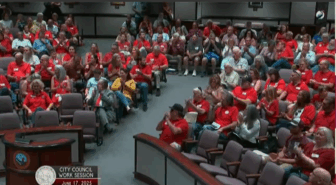I spent all afternoon at the New Orleans Police Department for climate organizing. I didn’t even get too close to Central Lock-Up so I can’t say I’ve gone to jail for an activist event…yet. I went downtown to the temporary police headquarters that are still housed in trailors because of the flooding during Hurricane Katrina over 2 years ago to apply for parade permits for Step It Up 2. Our event, on Saturday, November 3rd, will be extra special because along with a speaker’s forum and educational presentations, we will have a traditional New Orleans Second Line Parade in the heart of the city. Our main goals for the event are to educate the citizens
and students about the green organizations within the city that promote
clean energy and a more sustainable rebuilding process and to build a
relationship between students and citizens to extend the support network for
all the organizations involved in event. I’m excited to see all the details come together and know the event will be a wonderful success! I just wanted to thank everyone at CCAN and USCEC for all of the inspiration and experience you gave me this summer. This event would not be possible without ya’ll!!
This points to one of the real benefits of going green, of being environmentally friendly and energy efficient. There are the direct cost savings (estimated at $100,000 per year in lowered energy costs for T.C. Williams with a total additional cost of $1.2 million for going green — and much of that was not energy savings related in terms of additional cost) to be gained through going green.What is less often realized is that those energy savings are not even the tip of the iceberg in real benefits, in measurable impact from “going green”. Study-after-study of green buildings has found that there is improved worker productivity, reduced absenteeism, and improved retention (reduced turnover) which directly impacts the bottom line (helping companies make green by going Green). In addition, related to these is that workers have fewer health problems — working in a healthy space turns out to, surprise surprise, contribute to one's health.But, how to translate this into the school space?It turns out that there are measures to use … and by those measures, the benefits of going Green have real meaning. From AIA Architect:
A study in North Carolina revealed that children in schools with more natural day lighting scored 5 percent better on standardized tests than children in normal, comparable buildings.
What is the “value” of that 5 percent test score benefit? How much more would have to be spent on teacher salaries to get that sort of gain? It almost certainly would be far greater than a one-year amortized cost of going Green and increasing natural day lighting.
Thus, the TJ Williams students likely will not just suffer from not having their daytime naps but also suffer through the problem of having higher test scores (perhaps because they are snoring through fewer classes).
The National Academy of Sciences commissioned a study that indicated that teacher productivity and student learning, as measured by absenteeism, is affected by indoor air quality.
In other words, it isn't just that lighting … the healthier building has a healthy impact on the school environment.Sadly, the Post articlegave voice to shallow-based criticism.
The new three-story T.C. Williams, home to about 2,000 students, cost about $98 million, which is much higher than the price of many regular high schools its size. Alexandria school officials said the facility's green features account for about $1.2 million of its cost. Still, some educators and parents expressed skepticism about the cost of green schools.John Wilson, a commercial real estate salesman and the father of student J.W. Wilson, said he was surprised that he had not heard much protest about the school's cost. “I am happy that the students have the best of everything,” Wilson said, “but I am not convinced that it always translates into a better education.”
Well, the “best of everything”. Is Wilson focused on and upset about the $98 million? Or, is it the $1.2 million of greening that's got his goat? And well, again that $1.2 million will translate to $100,000 per year in lower energy costs, could reduce other direct costs (substitute teachers, health care compensation, etc), could lead to improved student health/happiness, and will, almost certainly, translate into improved academic performance of higher value than that $1.2 million each and every year.All told, for the citizens, that $1.2 million looks like a pretty good investment.Well, TJ Williams is not isolated. The latest issue of Eco-Structure has a focus, principally, on green schools. One discussion was on Guilford Northern Middle School in Greensboro, NC.
Michael Nicklas, project architect, said, “If educational buildings are respectful of the environment, the students will consider environmental stewardship an important value. Our schools should make a strong statement that saving energy and protecting the environment are important. The message that we give to future generations, through the schools we build for them, should not be underestimated.”
What are some of the school's features?
- daylighting will provide natural light at full-lighting levels to classrooms, administrative offices, the media center, the gymnasium, and the cafeteria during two-thirds of the school




